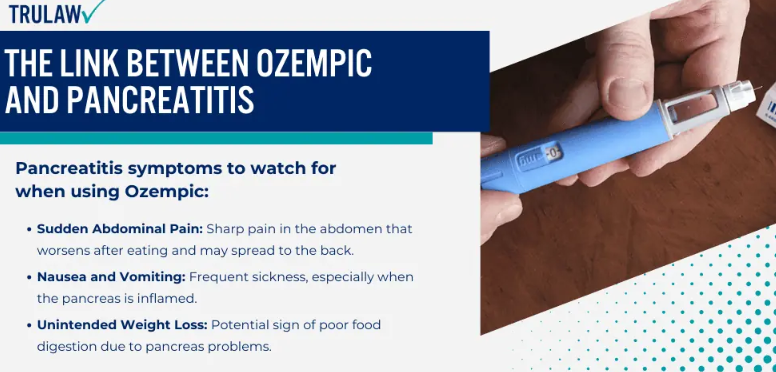BOURSESSENEGAL – Ozempic is becoming increasingly popular as a treatment for type 2 diabetes. However, many users have questions about its side effects, particularly regarding ozempic pancreatitis symptoms. In this blog post, we will delve into what Ozempic is, how it works, and the potential symptoms of pancreatitis associated with its use. Our goal is to provide clear, actionable information so you can make informed decisions about your health.
What is Ozempic?
Overview of Ozempic
Ozempic (semaglutide) is a glucagon-like peptide-1 (GLP-1) receptor agonist. It helps lower blood sugar levels and can aid in weight loss for those with type 2 diabetes. Patients administer it via a weekly injection, which simplifies the management of their condition.
How Does Ozempic Work?
Ozempic mimics the action of GLP-1, a hormone that your body produces to stimulate insulin secretion after meals. It also helps reduce appetite and slows gastric emptying. As a result, it plays a crucial role in regulating blood sugar levels and can significantly improve the overall quality of life for many individuals.
Why Pancreatitis is a Concern with Ozempic
Understanding Pancreatitis
Pancreatitis is the inflammation of the pancreas. This condition can be acute or chronic and may present serious health risks if not treated promptly. Symptoms can vary widely, but it’s essential to recognize them early to avoid complications.
The Link Between Ozempic and Pancreatitis
Research indicates a potential association between Ozempic and pancreatitis. While not everyone using Ozempic will experience this issue, understanding the signs is vital for proactive health management.
Recognizing Ozempic Pancreatitis Symptoms
Common Symptoms of Pancreatitis
When it comes to ozempic pancreatitis symptoms, being aware of the key indicators can help you seek timely medical attention. Common symptoms include:
- Severe abdominal pain: This pain often radiates to the back and may worsen after eating.
- Nausea and vomiting: Digestive distress can accompany abdominal pain.
- Fever: A low-grade fever can occur as part of the inflammatory process.
- Rapid heartbeat: This may happen due to pain or stress on the body.
- Unexplained weight loss: This can result from nausea and a reduced appetite.
Less Common Symptoms
In some cases, individuals may experience additional symptoms, including:
- Jaundice: Yellowing of the skin and eyes can indicate bile duct involvement.
- Changes in stool: Steatorrhea, or greasy stools, may occur if the pancreas cannot produce adequate enzymes.
What to Do If You Experience Symptoms
Seek Medical Attention
If you notice any of these ozempic pancreatitis symptoms, it’s crucial to consult a healthcare professional immediately. Early intervention can prevent severe complications.
Possible Diagnostic Tests
Your healthcare provider may recommend several tests to confirm a diagnosis of pancreatitis, including:
- Blood tests: Elevated levels of pancreatic enzymes may indicate inflammation.
- Imaging tests: An ultrasound or CT scan can visualize the pancreas and surrounding structures.
Managing Pancreatitis Symptoms
Treatment Options
If diagnosed with pancreatitis, treatment may vary based on severity. Options typically include:
- Hospitalization: Severe cases may require inpatient care for monitoring and management.
- Pain management: Medications can help alleviate discomfort.
- Dietary changes: A low-fat diet is often recommended to reduce pancreatic stress.
- Hydration: Intravenous fluids may be necessary, especially in acute cases.
Lifestyle Adjustments
In addition to medical treatment, lifestyle modifications can play a vital role in managing symptoms:
- Avoiding alcohol: Alcohol can exacerbate pancreatitis and should be completely avoided.
- Regular follow-ups: Consistent check-ups with your healthcare provider can help manage long-term health.
- Balanced diet: Focus on a nutrient-rich diet to support overall health.
Preventing Pancreatitis While Using Ozempic
Inform Your Doctor
Before starting Ozempic, it’s essential to discuss your medical history with your healthcare provider. If you have a history of pancreatitis or gallstones, your doctor may recommend alternative treatments.
Monitor Symptoms Closely
Regularly assess your health for any signs of pancreatitis while using Ozempic. If you notice anything unusual, don’t hesitate to reach out to your healthcare provider.
Educate Yourself
Understanding the risks and benefits of any medication is vital. Research and stay informed about potential side effects associated with Ozempic.
Conclusion: Empowering Your Health Journey
Awareness of ozempic pancreatitis symptoms can help you take control of your health. While Ozempic offers significant benefits for managing type 2 diabetes, it’s crucial to recognize the signs of potential complications. Always prioritize open communication with your healthcare team and take proactive steps to safeguard your health.
By understanding how Ozempic works, the symptoms of pancreatitis, and effective management strategies, you can make informed decisions about your treatment. Empower yourself with knowledge and take charge of your health journey today.
In the end, staying informed not only enhances your well-being but also fosters a collaborative relationship with your healthcare provider. Remember, your health is in your hands, and taking action can lead to better outcomes.
REFERENCE : https://www.health.com/



